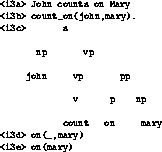


Next: Efficiency considerations Up: A comparison between Previous: A comparison between
Semantic monotonicity vs. semantic heads
The semantic monotonicity requirement entails that analyses that require some noncompositionality are impossible. A first example of this are prepositional verbs like 'count on'. Assume that sentences like <13a> have a semantics like <13b>, and are built like <13c>.

This means that at a certain stage in the analysis a pp exists with, probably, its own semantics. This semantics will look like <13d> or <13e>, which both do not subsume any part of <13b>. Therefore this analysis is not semantically monotonic. A semantically monotonic analysis of these examples will need a rule similar to <14>.

So prepositions that can occur in prepositional verb constructions need to be analyzed as function words without significant semantics. This leads to redundancy and ambiguities, as sometimes these prepositions must contain specific semantic information. This 'escape hatch' is not available for more complicated noncompositional examples as is the case for idioms. Suppose we want to analyze <15a> as <15b>.

This analysis is entirely impossible within Shieber's framework because the noun phrase 'the bucket' can never be generated since it does not subsume part of <15b>. It seems that nothing can be done about this. Both examples show that noncompositional cases cannot (or not without serious problems) be handled with grammars that are semantically monotonic. However, both examples can be analyzed in a way that observes the semantic head requirement. The lexical entry 'count_on' will contain the equations <16>.

At the time a vp dominating 'count' is constructed in the generation process, the semantics for the pp is instantiated by a rule similar to rule <2> of section 1. Therefore no problems arise. The same applies to idioms. One reading of the verb 'kick' will contain the following equations <17>.

Again this will force an object 'the bucket' to be generated while the semantics is kept very simple. I conclude that several analyses are impossible with semantically monotonic grammars that are possible for grammars that observe the semantic head requirement.
One might wonder what the answer to the opposite question is,
i.e. do there exist analyses in semantically monotonic grammars that
are impossible within my approach. It is clear that these must exist
(e.g. by choosing the 'wrong' daughters as the semantic head in a
semantically monotonic grammar); however I did not yet come across
examples that make a crucial use of this.
For the moment it seems that the semantic head requirement is linguistically
more relevant than Shieber's monotonicity requirement.



Next: Efficiency considerations Up: A comparison between Previous: A comparison between
Gertjan van Noord
Fri Nov 25 13:48:52 MET 1994